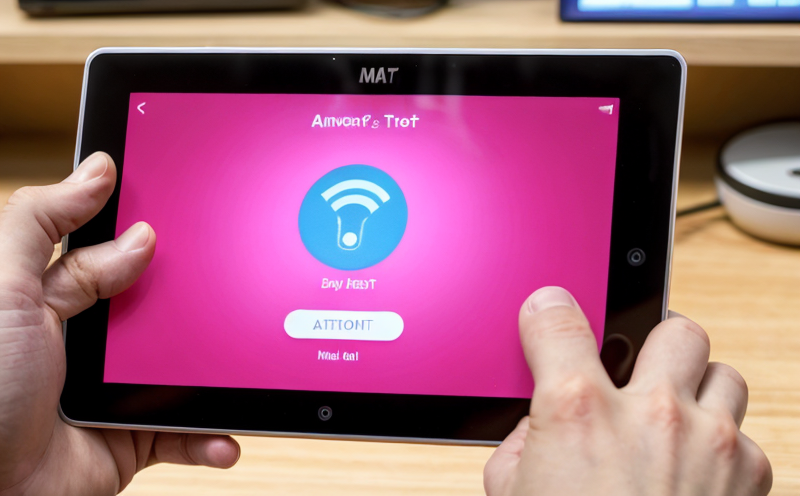Leakage Current Testing in IoT Products
The safety of consumer products is a critical concern, especially when it comes to smart and connected devices that are increasingly integrated into our daily lives. Leakage current testing ensures that these devices do not pose an electrical hazard by measuring the unintentional current flow from conductors within the device to earth or supply lines. This test is particularly important for IoT products as they often incorporate multiple electronic components, power sources, and wireless connectivity, which can introduce additional risks if not properly evaluated.
IoT devices such as smart home appliances, wearable technology, and connected medical devices are designed to operate without human intervention over extended periods. Any leakage current can lead to potential hazards including shocks or fires, which could compromise the safety of users. Regulatory standards like IEC 62368-1 and UL 62368-1 specify limits for leakage currents in various applications, ensuring that devices meet these stringent requirements.
The testing process involves subjecting the IoT device to specific conditions designed to mimic real-world usage scenarios. This includes applying different voltage levels and measuring the resulting current flow through the device under test (DUT). The DUT is typically connected to a circuit that simulates an earth fault, allowing for accurate measurement of leakage currents. The test setup must also account for any additional components such as batteries or wireless modules that might influence the overall performance.
Proper specimen preparation is crucial before conducting leakage current tests. This involves ensuring that all connections are secure and that there is no loose wiring or exposed conductors which could affect the test results. Additionally, it’s important to verify that the device operates correctly under normal operating conditions since any malfunctions can lead to inaccurate readings.
Once prepared, the DUT undergoes rigorous testing using appropriate instrumentation capable of detecting very low levels of current down to microamperes (µA). Automated test systems are often employed due to their precision and repeatability. These systems typically consist of a power supply, a grounding resistor network, and specialized measurement equipment designed specifically for measuring small currents.
The results from these tests provide critical insights into the safety performance of IoT products by identifying any potential risks early in the development cycle. Compliance with established standards not only protects consumers but also ensures that manufacturers remain competitive within their respective markets while adhering to global regulations.
Scope and Methodology
The scope of leakage current testing encompasses evaluating the effectiveness of insulation barriers between conductors and the ground, ensuring no hazardous levels of current flow under specified conditions. The methodology involves setting up a controlled environment where various parameters such as voltage applied, duration of exposure, and environmental factors are carefully monitored.
- Standardized Conditions: Testing is conducted according to internationally recognized standards like IEC 62368-1 which define the allowable limits for leakage currents based on product type and category.
- Data Collection: Continuous monitoring of current flow during different stages of operation helps in pinpointing any anomalies that could indicate a fault or design flaw.
- Analyze Results: Comprehensive analysis is performed post-testing to determine compliance with regulatory requirements and identify areas requiring improvement.
The methodology also considers the impact of environmental factors such as humidity, temperature variations, and altitude changes on the performance of IoT devices. By simulating these conditions during testing, engineers can better understand how well their products will withstand real-world challenges.
Industry Applications
- Smart Home Devices: Leakage current tests are essential for verifying the safety of smart thermostats, security cameras, and other connected home gadgets that users interact with frequently.
- Wearable Tech: Ensuring that fitness trackers and smartwatches have safe operating characteristics is paramount given their direct contact with human skin over prolonged periods.
- Medical Devices: Lifesaving equipment such as pacemakers, insulin pumps, and remote patient monitoring systems must pass rigorous safety checks to prevent life-threatening incidents.
- Automotive Electronics: Modern vehicles contain numerous electronic components that need to function reliably even in adverse conditions. Leakage current testing helps maintain passenger safety by minimizing risks associated with electrical malfunctions.
Customer Impact and Satisfaction
By implementing thorough leakage current testing, customers can rest assured knowing that their smart devices operate safely without posing any unforeseen hazards. This builds trust between manufacturers and consumers, fostering long-term relationships built on reliability and quality.
- Increased Safety: Meeting stringent safety standards enhances customer confidence in the product’s ability to protect them from electrical dangers.
- Better Product Life: Identifying and addressing issues early through testing prolongs the lifecycle of IoT devices, reducing maintenance costs and downtime.
- Enhanced Reputation: Demonstrating commitment to safety sets brands apart in a competitive market, attracting more buyers who value responsible practices.





